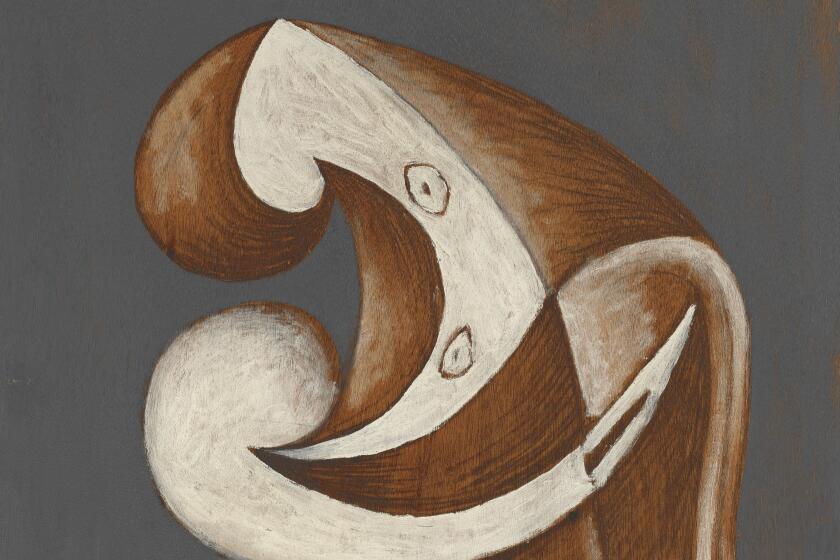Review: Hans Holbein struts his stuff at the Getty Museum
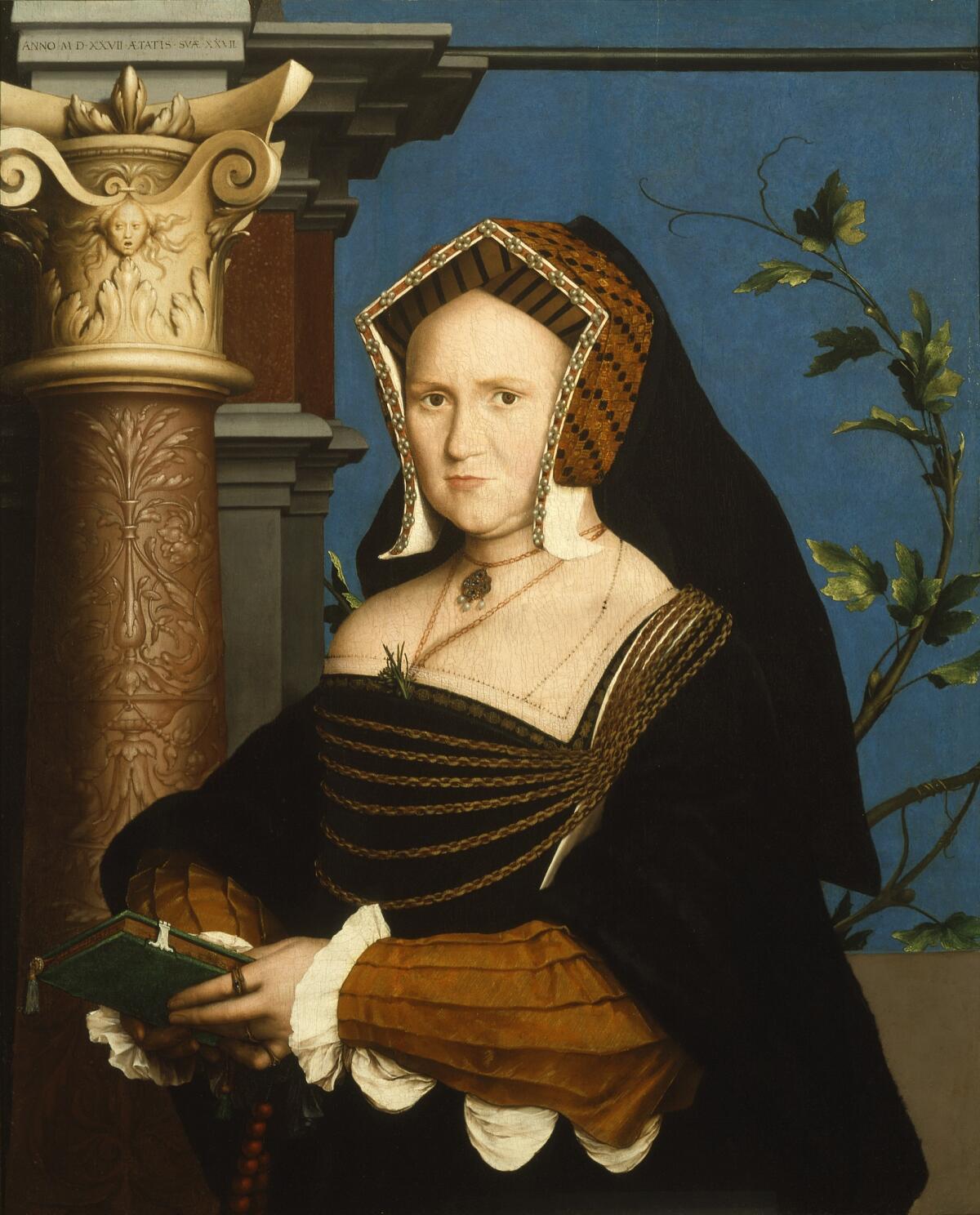
- Share via
The unprecedented exhibition of Renaissance portraits by Hans Holbein the Younger at the J. Paul Getty Museum opens with a bang.
His staggeringly beautiful painting of a young woman, wife of a London courtier, sits dead ahead on the entry wall. Shown in standard, waist-high, three-quarter view, she appears decorous and composed while accompanied by two unexpected pets, both shown in profile.
A furry red squirrel nibbling on a nut is held on a delicate chain clasped in her hand. Just behind her right shoulder, as if poised to whisper in her ear, a shiny-feathered starling perches on a branch.
The animals do double duty. Materiality meets symbolism.
Holbein’s magnificent, visually seductive displays are intensified by the material textures he piles onto them. The squirrel’s bushy red fur, the bird’s sleek feathers and the glistening gold chain join the dense white fur of the young woman’s hoodlike cap, the fine strands of her neatly parted hair, the linen shawl draped around her shoulders, the filmy transparency of her dress’ sheer bodice and the gentle white ruffle on the cuff peeking out from beneath her sleeve.
Holbein is strutting his stuff. Like itinerant artists everywhere throughout history, he needed to show the uninitiated what he could do.
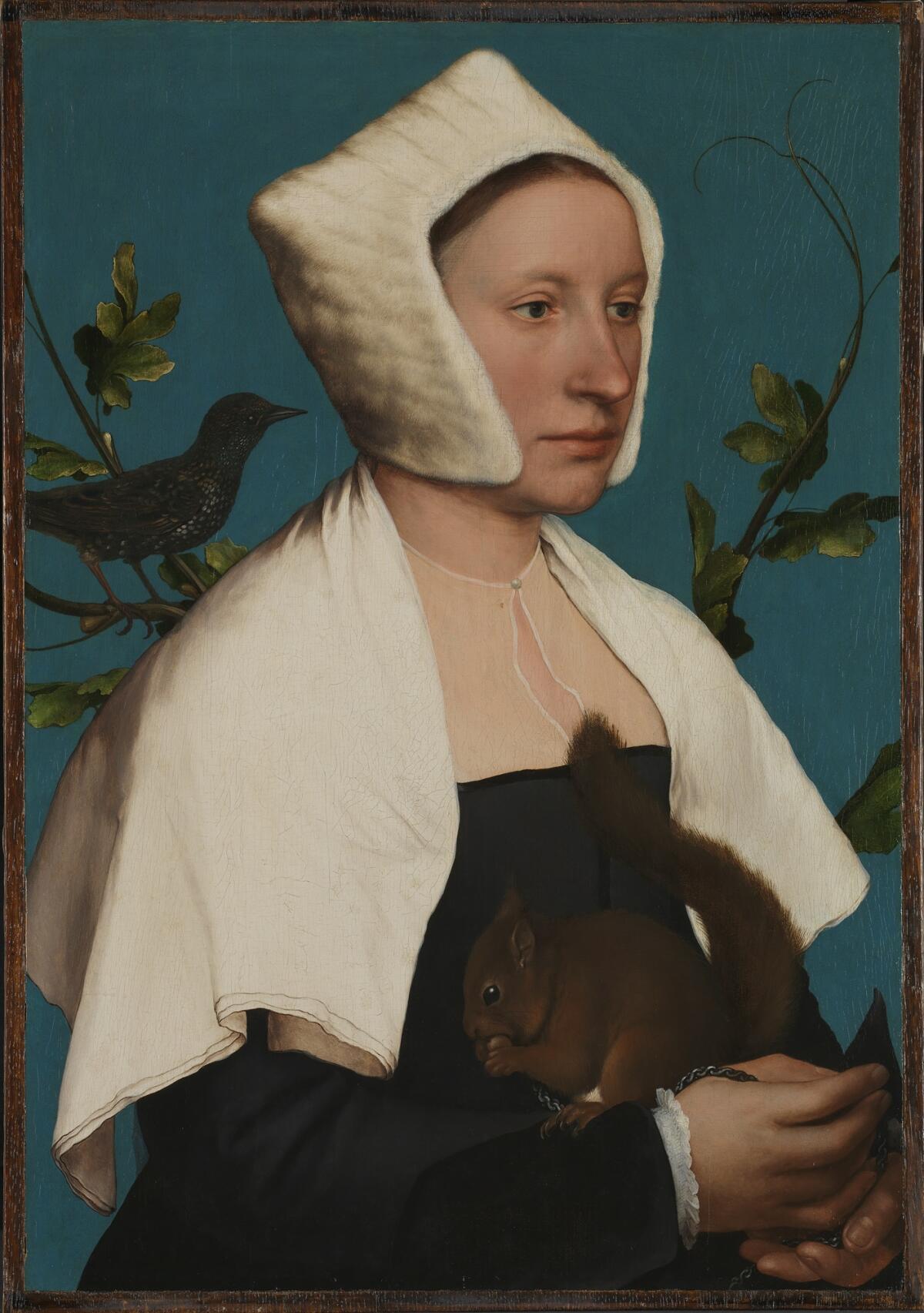
The German artist, born in Augsburg in late 1497 or early 1498, was about 29 or 30 when he painted “A Lady With a Squirrel and a Starling (Anne Lovell?).” He grew up in a successful family of artists, which included a grandfather, father, uncle and brother, and he ached for steady work. After kicking around Europe — mostly Switzerland and the Netherlands — he traveled to England for the first time to drum up patronage. London was a tough market to crack, but the estate of the lady’s courtier-husband was one of many in the countryside — this one, 100 miles north in Norfolk county.
Hence, the symbolism.
Squirrels, playful yet industrious, are featured in Richard Lovell’s family crest. That has led scholars to conclude that the unidentified woman in the painting is likely his wife, Anne Ashby. (Holbein painted the portrait around the time she gave birth to an heir — a son, all-important to a patriarchy of landed gentry.) For its part, the starling also functions as a visual pun, a play on the name of the Norfolk village of East Harling.
The 20th century Dada trickster Marcel Duchamp isn’t the only artist who toyed with verbal puns in his work, setting off the contemporary chain reaction in Pop and Conceptual art. That the bird whispers in Anne’s ear signals that a viewer should “hear” the language embedded in the name of the bird’s species. The visual becomes audible.
Several portraits show people clutching the likes of gloves or tools. Books and folded papers are featured most prominently, though. Holbein’s attention to a visual intersection with language is essential to his appeal in Britain. There, the power of the written word has usually bested painting in the long history of the liberal arts.
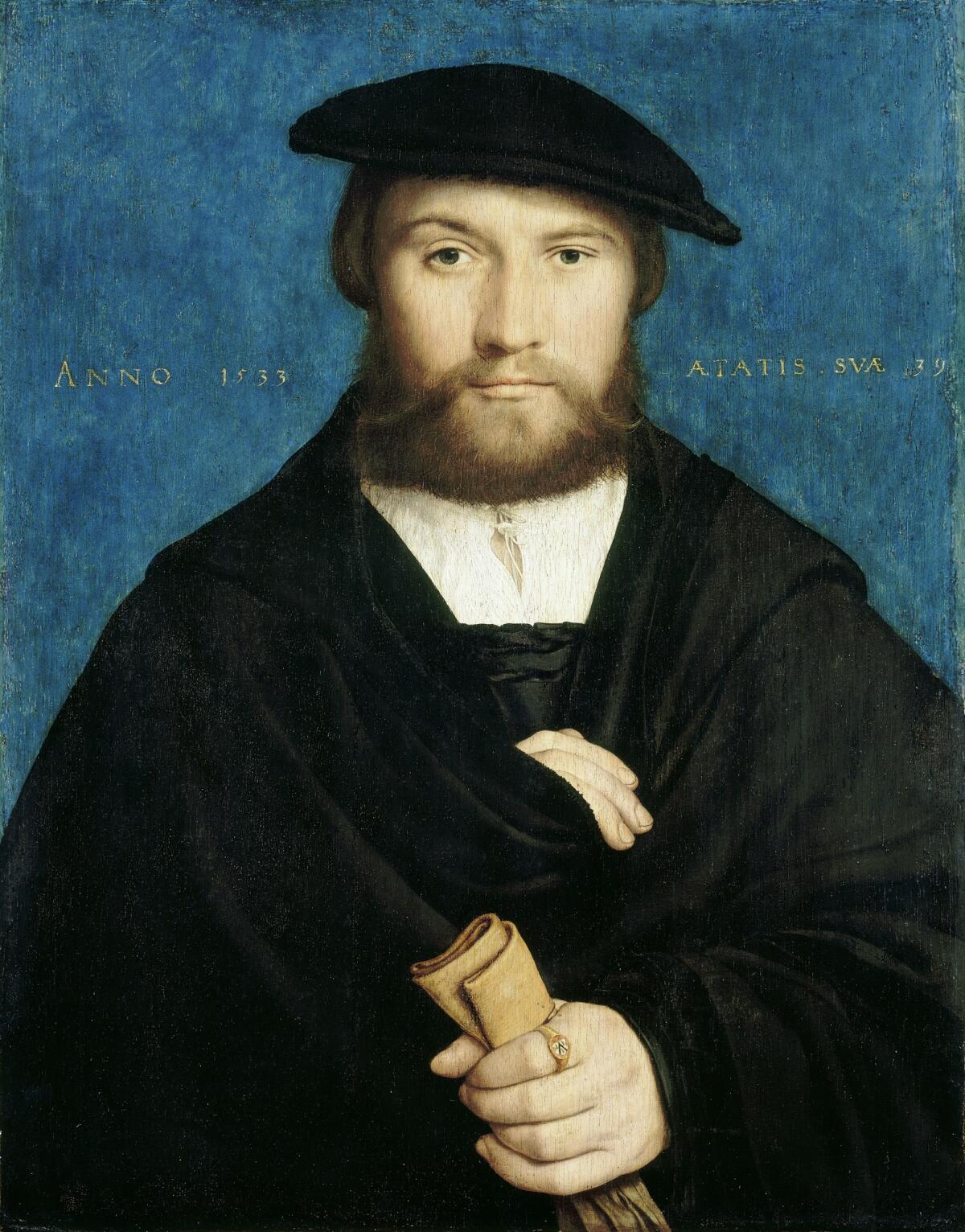
Then there was Erasmus, the great Dutch humanist philosopher with whom Tudor England was obsessed. Erasmus held that writing occupied a higher rung on his aesthetic ladder than making pictures did. He was Catholic — in fact, the illicit son of a priest — but he also admired certain tenets of the Protestant Reformation, including caution about the potentially devilish power of images.
Erasmus was supportive of Holbein, albeit with reservations noted about the picture thing. His backing proved instrumental in the artist’s commercial success, including his later ascension to the rank of court painter to Henry VIII, the profligate intellectual who sat on the English throne from 1509 to 1547.
While the Metropolitan Museum of Art is treating its collection like a bank, UCLA’s Hammer Museum shows a smarter approach to deaccessioning art.
Holbein’s seamless union of materiality and symbolism was more than merely showy. Instead, it’s what makes the flesh-and-blood verisimilitude of his portraits so captivating.
What skill. For “A Lady With a Squirrel and a Starling (Anne Lovell?),” modern high-tech imaging techniques have revealed that the painting was almost finished when Holbein added the animals — a move that required deft compositional adjustments, especially around the lady’s hands. Holbein may have been responding to a patron’s last-minute request to make the addition, but he pulled it off smoothly.
“Hans Holbein: Capturing Character in the Renaissance” was organized by Getty curator Anne Woollett together with Austėja Mackelaitė and John T. McQuillen of the Morgan Library and Museum in New York, where it travels in February. The show features 33 paintings and drawings by the artist. According to the museums, there have never been so many Holbein panels — 20 at the Getty — in an American show.
The pandemic required juggling some loans, so the show will look slightly different at the two venues. And COVID-19 grimly underscores Holbein’s tragic death at around age 45, believed to have been the result of a virulent plague that raged in London during the winter of 1543.
The show also features an illuminating array of several dozen contextual objects — everything from letters and medallions to engravings, ornamental hat badges and recent X-ray analyses — that elucidate Holbein’s working habits. The inclusion speaks to how Holbein’s portraits weren’t just immediate records of what he saw, but were instead assembled over time.
A few portraits by other contemporaneous artists, most notably Flemish painter Jan Gossaert, are included for comparison. The catalog is excellent.
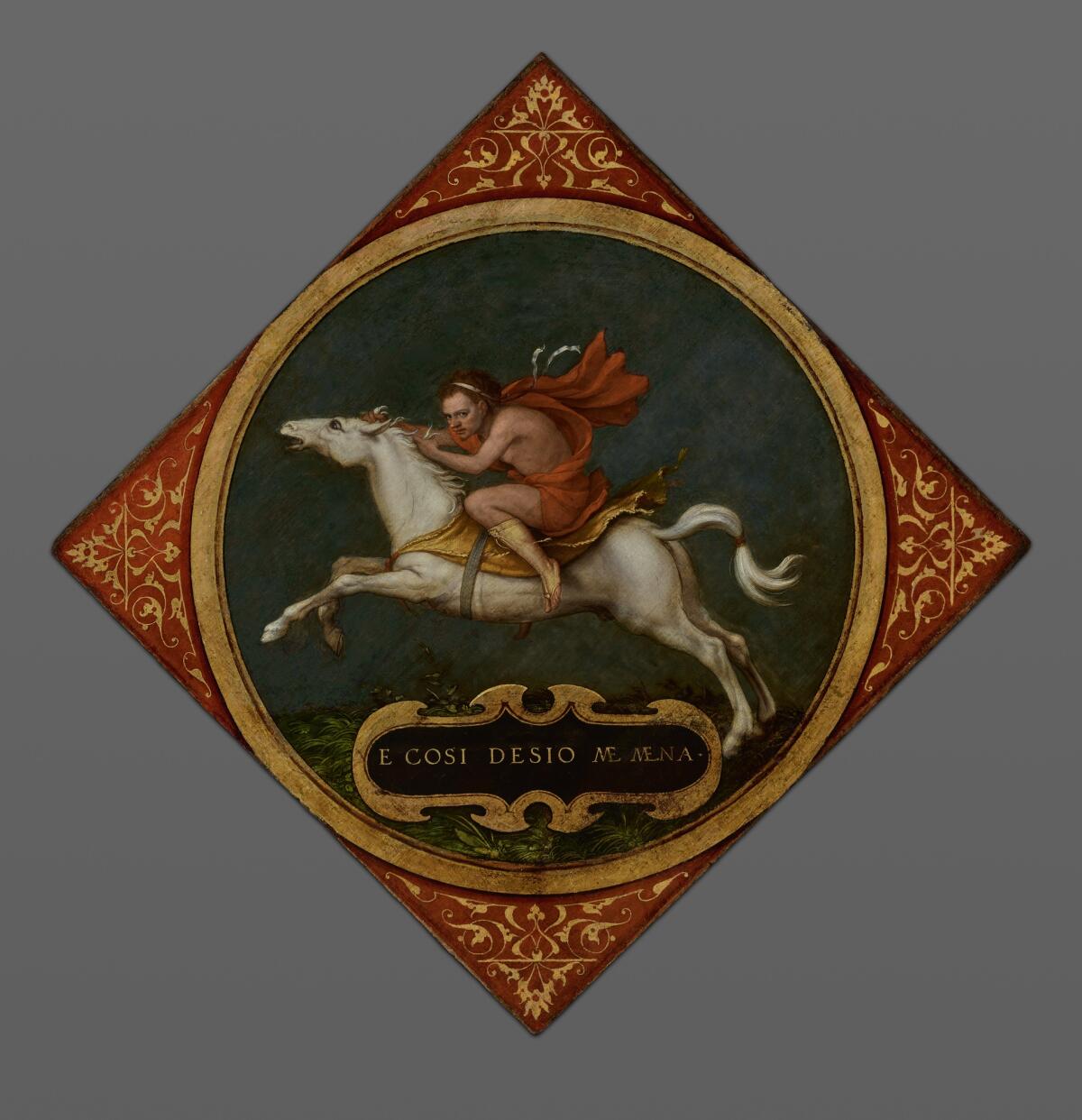
Appropriately (if somewhat ironically), the exhibition means to shine a light on one of these contextual elements — an unusual Holbein in the Getty’s own collection. “An Allegory of Passion” is not a portrait; it shows a rider in classical toga charging ahead on the back of a galloping white steed. But the diamond-shaped panel does illustrate a line from the poet Petrarch about chasing desire. It’s one more example of the intersection of image and language that animated Holbein’s thinking.
The power of human desire provides a good explanation for the Renaissance efflorescence of portraiture as a major artistic theme. There are others, including a class-minded yearning to display vast wealth and assert power. That lady’s pet squirrel doesn’t merely identify family. It flaunts the upper-class distinction of even having a family crest.
Elsewhere, through the intricate gold threads woven one by one into the elaborate headdress worn by a pious “Mary, Lady Guildford,” Holbein created a veritable halo for an aristocrat. (Her husband was comptroller for the spendthrift Henry VIII). Stunning verisimilitude melds each stylish strand, gleaming in the light, with the sitter’s authority of being one of the few able to afford a painting’s commission.
Then there’s the alert gaze of a predatory hawk, perched in the foreground on the gloved hand of an unidentified, apparently status-climbing nobleman. (The bird was another last-minute addition to a virtually finished likeness.) The all-black garb, buttons askew and golden jewelry poking out, of the ruthless courtier, “Richard Southwell,” asserts severity.
Through portraiture, these are all folks quietly but firmly saying: “Don’t mess with me.”
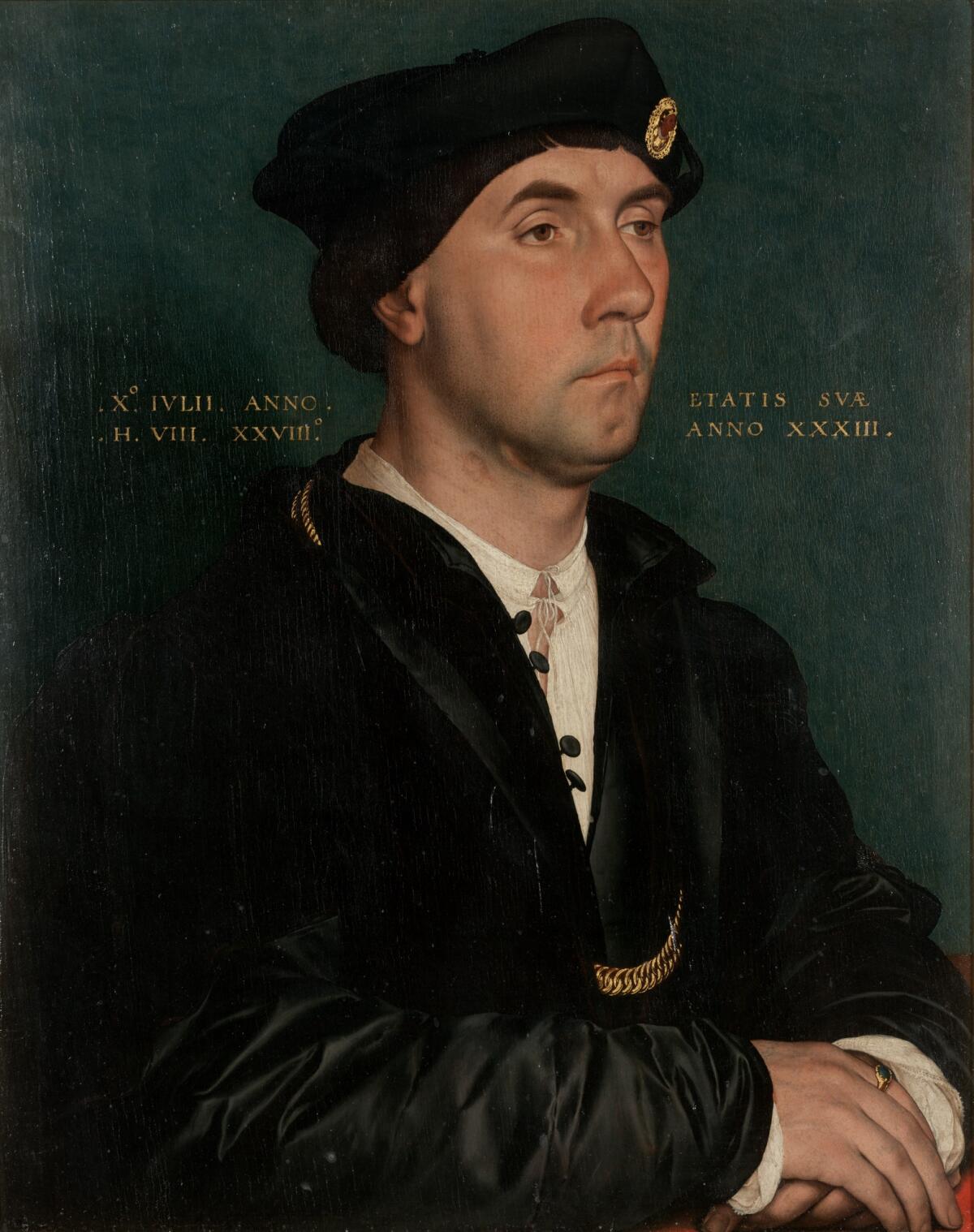
Southwell, hands folded and eyes focused laser-like ahead of him, sits formally before a rich green wall nearly as forbidding as his dark clothing. But is it any wonder that Holbein’s favored setting for many of these portraits involved a flat plane of celestial blue? The sitters occupy heaven and earth at once.
Think of it as an elevated English Renaissance version of today’s vulgar prosperity gospel that equates Christian faith with material success — say, Joel Osteen or Benny Hinn without the tacky taste.
Missing from the show is “The Ambassadors,” the signature British painting in London’s National Gallery. Holbein’s most famous portrait is a double whammy, famous for the big, wildly distorted, anamorphic human skull spread across the bottom of the picture, where it underlines the two life-size, full-length figures of an imposing French ambassador and his clerical pal.
Dressed in sleek pink satin, fluffy white lynx and shiny black silk, the stately nobleman resembles an overstuffed Renaissance box of Good & Plenty candy. The skull, composed on a raking angle that matches the jaunty slant of the man’s cap, gives him a perceptually acute visual emblem for the Latin text of his motto: memento mori — “remember, you must die.”
The absence of “The Ambassadors” from the Getty is hardly a surprise. The masterpiece did not travel because, at nearly seven feet square and one of the largest known Renaissance oils painted on wooden panel, it is just too fragile for such a trip. It’s miracle enough that 19 smaller Holbein panels have made the journey from major museums around the United States and Europe.
In July, when we learned that the Huntington Library, Art Museum, and Botanical Gardens in San Marino made the mistake of agreeing to lend its physically delicate icon, “Blue Boy,” to London’s National Gallery in January, I hoped for a split second that in exchange, maybe the British museum might lend its equally iconic Holbein “Ambassadors.” But that, of course, would have been just as dangerous an arrangement. A prominent, less vulnerable Joseph Wright of Derby canvas is coming instead.
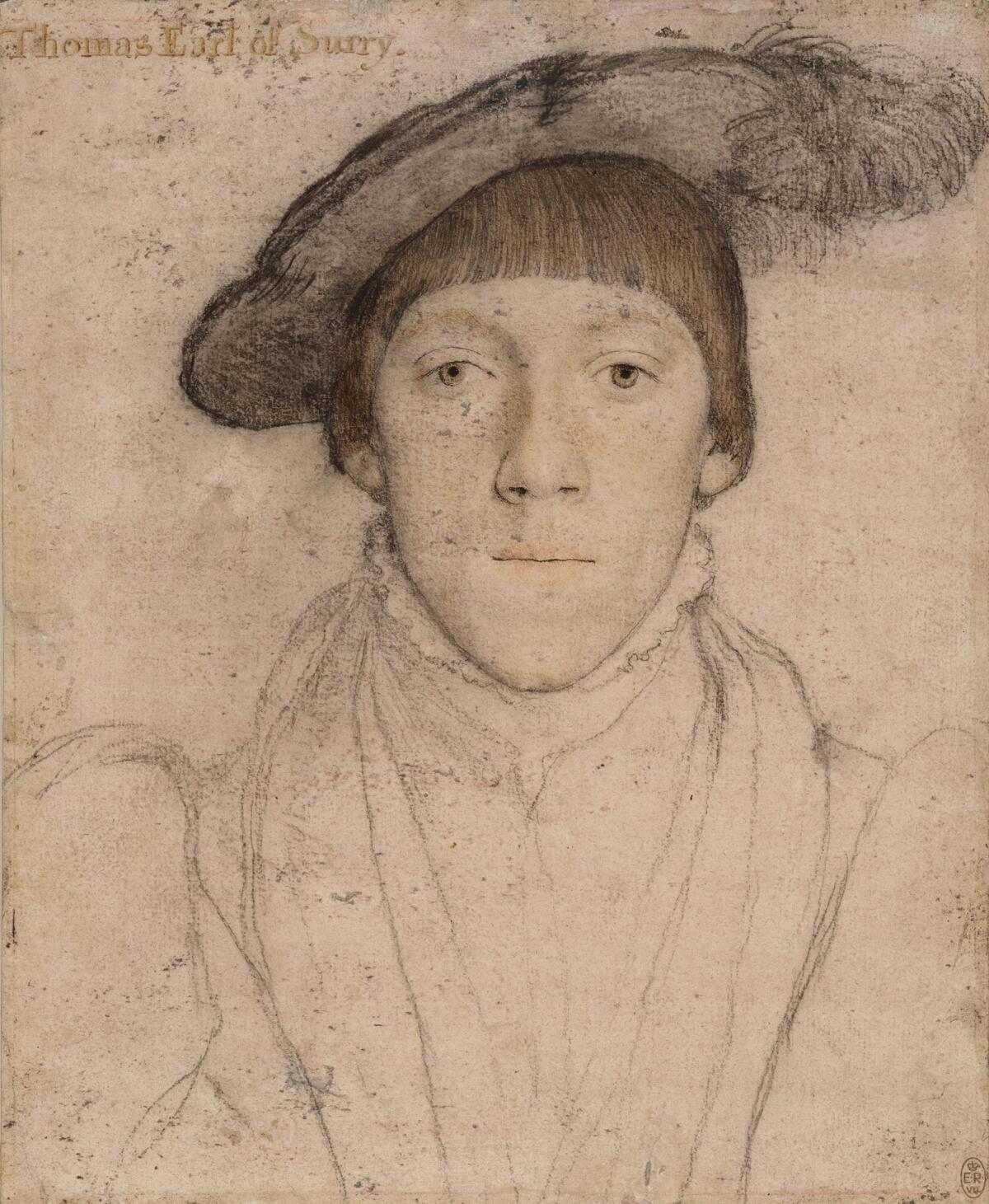
London did lend the knockout Anne Lovell and her animals, though, and the queen of England has been generous with drawings from among the 80 in the Royal Collection. Together with the rest — including the Getty’s own chalk and ink study of a scholar, the artist’s sole drawing in North America — they make for an unmatched experience.
Just remember what felled Holbein and, when you go, be sure to wear your mask.
'Holbein: Capturing Character in the Renaissance'
Where: J. Paul Getty Museum, 1200 Getty Center Drive, Brentwood
When: Tuesdays-Sundays, through Jan. 9
Cost: Free
Info: (310) 440-7300, www.getty.edu
More to Read
The biggest entertainment stories
Get our big stories about Hollywood, film, television, music, arts, culture and more right in your inbox as soon as they publish.
You may occasionally receive promotional content from the Los Angeles Times.
